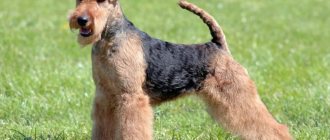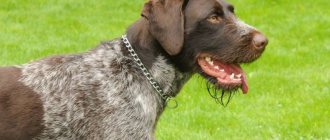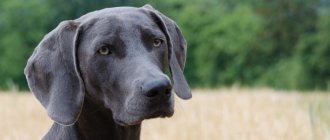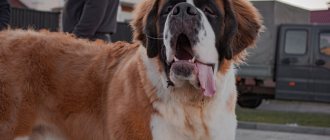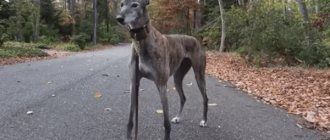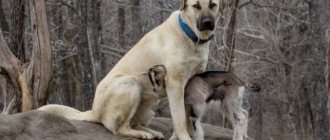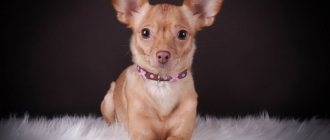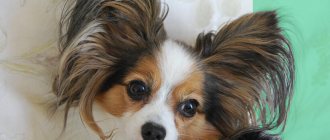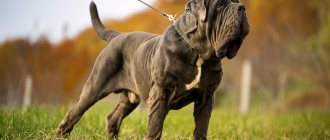Breed characteristics
| Short description | |
| Origin: | England |
| Conditions of detention: | In a house, in a house with a garden, in an apartment |
| Purpose: | Hunting, companion |
| Color: | Brown with black or grayish-black shirt |
| Wool length: | Average 5-6 cm |
| Adult dog size: | The height of females is 34-38 cm, males - 35-40 cm, weight of males is approximately 10 kg, females - 9.5 kg |
| Average life expectancy: | 14-16 years old |
| Walk: | Once a day for 30-60 minutes |
| Physical activity needs: | Average physical activity needs |
| Fédération Cynologique Internationale (FIC) classification: | Group No. 3 terriers; Section No. 3 large and medium sized terriers |
| Puppy price: | From 10 to 30 thousand rubles. |
Health
The average life cycle of a Welshman is approximately fourteen years. However, it is worth noting that with proper feeding and proper care, this period can definitely be extended.
As for the basic endurance and level of health, the breed is not susceptible to pathologies, but the weak point of the Welsh is precisely the visual organs.
If we consider the main diseases that a representative of the species in question may encounter throughout his life, they are for the most part the following:
- cataract;
- glaucoma;
- epileptic seizures;
- problems with the vegetative-vascular system.
History of the origin of the species
The Welsh Terrier is a breed of English origin. The appearance of the species is explained differently everywhere. The ancestor of these dogs is the English Terrier. It had a black color with tan marks and was used in agriculture and hunting. The terrier helped pull out prey hidden in a hole.
Catching rodent pests was an outstanding ability, entertainment and one of the household duties of the ancestors of this breed.
The Welsh Terrier in its modern form has been cultivated since the 19th century. The characteristics of the breed were recorded in 1885. The first club of Welsh Terrier dog breeders was founded in 1886. At the turn of the 19th and 20th centuries, 100 representatives of the breed were presented at a dog show in Liverpool. Since then, the hunting breed has earned recognition in Foggy Albion. In the 1970s, the Welsh Terrier gained international recognition.
Application
The historical purpose of the Welsh Terrier is as a hunter. A dog, trained from an early age for burrow hunting, performs these functions, being an excellent assistant.
Increasingly, the Welsh Terrier breed is used as a pet, as a companion, as a friend. A new direction in medicine – canestherapy – is becoming increasingly popular. Communication with animals helps lonely and withdrawn people to relax. In his own way, he is a home psychotherapist.
Welsh Terriers have a sensitive sense of smell. They are successfully used in search operations to rescue missing people. In law enforcement agencies, Welsh are used when searching for narcotic and explosive substances.
Distinctive features
The main distinguishing features of purebred dogs are:
- The head is square and flat. The transition from the muzzle to the forehead is weakly expressed.
- The eyes are dark in color, small, deep set, reflecting the character of the dog.
- The ears are triangular in shape, set high, and have drooping tips.
- The bite is correct, scissor-shaped, the jaws are powerful and well developed.
- The neck is short, dry, wide at the shoulders and thin at the head.
- The legs are of medium length with slender and parallel thighs.
- The body is muscular with a flat and long back. Rounded ribs.
- The tail is set high and may be docked.
- The coat is wiry, coarse and dense.
Nutrition
These dogs have an excellent dental system, so they can eat both natural products and canned food (at the owner’s discretion). If your pet regularly gets outdoors and runs around a lot, he should eat a lot to replenish his energy.
An adult representative of the breed must eat at least 600 grams of food per day. It is advisable to divide this amount of food into 2 meals. That is, he should eat no more than 300 grams of food in one meal.
The Welsh Terrier puppy eats little by little. It must not be overfed! The fact is that the baby terrier’s digestive system has not yet had time to form, therefore, for better absorption of nutrients, he needs to eat often and in small portions.
The main food of a growing Welshman is raw meat. If desired, it can be subjected to heat treatment, for example, welded. Important: if you are concerned that raw meat contains parasites that could enter your dog's body, then simply scald it with boiling water before giving it to him.
Also, before completely switching to canned food (you can also give dry food), include in your terrier puppy’s diet:
- Mashed potatoes.
- Applesauce.
- Vegetable soup with chicken fillet added.
- Dairy products: cheese, milk, cottage cheese, butter.
- Boiled porridge.
Never feed him sweets, baked goods, fatty fried meats or foods prepared with a lot of spices.
Photo of an adult dog
Bobtail or Old English Sheepdog
Main characteristics:
- Height at withers: 56-61 cm.
- Weight: 30-45 kg.
- Wool, color: long, shaggy fur, color - any shade of gray, silver or blue.
- Temperament and other personal qualities: adaptable, obedient, intelligent.
- Life expectancy: 10-12 years.
Perhaps the most iconic and popular dog breed comes from Foggy Albion. The Old English Sheepdog has a reputation for being gentle, intelligent and easy-going. Its long, thick fur with a soft undercoat gives its owner a bear-like appearance.
Bobtails can have only one color - gray bicolor: the head, neck and forelimbs are white, and the back, sides and croup are gray or blue (shades may vary).
The Old English Sheepdog is a calm and laid-back dog. This is an affectionate pet that gets along well with all family members. In addition, the bobtail can be very playful, especially since the dog grows up to three years.
At first glance, the bobtail looks ridiculous and even stupid, but this impression is deceptive. After all, these are herding dogs. Bobtails are very energetic, active, smart and agile, and therefore require a decent amount of physical and mental training.
Interesting Facts:
- Historians believe that there may be something Russian or Scottish about these dogs.
- Although they are called "old" bobtails, they are a relatively new breed, having been officially registered in 1904.
Photos of puppies
English hounds
Bloodhound
Hound dogs play a very important role for hunters. Possessing an incredible sense of smell, these dogs can easily and quickly track down game, thereby saving the hunter many hours that he would otherwise spend searching for prey on his own. And given how popular hunting was in England, hounds had great authority and were considered the most important dogs for society.
The list of English hounds includes the following breeds:
- bloodhound;
- greyhound;
- beagle;
- whippet;
- otterhound.
Features of character and behavior
The Welsh Terrier inherited the key traits of its ancestors - hunting passion and increased activity. He is active and ready for hours of play. The Welsh Terrier is independent, always takes the initiative into his own hands, without waiting for the owner’s commands.
The Welsh Terrier is a fan of long, active walks. When purchasing this dog, you need to be prepared for your pet’s regular hours of fun in the fresh air and the manifestation of hunting abilities within the walls of the home.
A born hunter, the Welsh Terrier will always find an opportunity to return to the original occupation of his great-grandfathers . In the fresh air, the dog will tirelessly chase a ball or stick, seeing it as an object of hunting. At home, instincts and outstanding olfactory abilities will help the Welsh Terrier easily find hidden treats.
Advantages
Positive aspects of the Welsh Terrier's character:
- With proper upbringing, he becomes a loyal, obedient and cheerful family friend.
- Enjoys participating in active family and children's games.
- Positive and sociable.
- Focused on results. The purposefulness of the Welsh Terrier, ready to pursue a goal until the victorious finale, makes it a worthy companion for any hunter.
Flaws
Difficulties of the Welsh Terrier's character that must be taken into account:
- Restlessness . It cannot be eradicated even by active training. The only way out of the situation is to take the dog’s restlessness for granted and show maximum patience and understanding to your friend.
- Cockiness . The Welsh Terrier is always ready to show other dogs who is boss. This should be taken into account when walking and prevent the dog from meeting another dog of the same hot-tempered nature.
- Threat to small animals . The Welsh Terrier sees them as an object of hunting and is determined to attack the potential victim. For the latter, the consequences of a meeting with a Welsh Terrier may be the most tragic.
Owners' opinions
Based on the opinion and experience of breeders, we can say that reviews of the Welsh Terrier are mostly positive.
Everyone, as one, notes the amazing devotion of this creature, endless cheerfulness and incredible ingenuity.
The dog will become a good friend for a teenager, an excellent companion for active older people and simply a full member of a large and friendly family.
The difficulties in education that owners face are also typical: hyperactivity, cockiness, complete submission to their hunting instincts. All this can be easily overcome and corrected by paying enough attention to raising the dog.
Care and maintenance
An English hunter can live either in an apartment building or in a cottage.
- A country house with an adjacent plot and a fence is an acceptable option . The Welsh Terrier is able to live in urban environments and in nature. In any case, the main requirement for the Welsh Terrier’s habitat is the availability of opportunities for active walks.
- Speaking about hygiene procedures, it is necessary to mention regular cleaning of ears and teeth. As mentioned earlier, the eyes of Welsh Terriers are susceptible to inflammatory diseases, and therefore especially need care - wiping the corners with a cotton pad to remove the accumulation of hairs.
- To prevent plaque, which can develop into tartar , you need to thoroughly brush your teeth with a special paste for dogs or household baking soda.
Nutrition
The Welsh Terrier is not a gourmet. His tastes in food are unpretentious and extend to a wide range of foods. A dog's diet can include both specialized pet food and food from the human menu. The exception is carbohydrate foods - bread and potatoes.
Changes in diet and replacement of dry food with natural food (or vice versa) are possible. The main thing is not to do this too often and without significant reasons.
If the Welsh Terrier eats natural food, it is worth introducing special vitamin supplements into its diet. The veterinarian will help you choose the necessary vitamin complex.
Foods that are not suitable for dogs of this breed:
- products made from butter flour: bread and pasta;
- large and tubular bones;
- smoked and canned products;
- confectionery.
The diet of a small Welsh Terrier is up to 6 times a day in small portions. As we age, the number of meals we eat decreases and the amount of food in our bowl increases.
An adult Welsh Terrier receives food twice a day at strictly fixed hours . The amount of food depends on the age and size of the animal. Carefully licking the bowl and rolling it on the floor is a sign that the pet does not have enough food.
Leftover food on the dog’s plate is a reason to reduce the amount of food . If the dog eats all the contents and calmly parts with the empty dishes, then the portion is suitable for the pet.
This breed is characterized by curiosity and increased attention to inaccessible or hidden food. Given a convenient opportunity, the Welsh Terrier will definitely eat treats recklessly left by a person. The owners of such a dog should prevent him from any attempts to receive treats from strangers or begging of the pet at the dinner table at home.
Health
The average life expectancy of a Welsh Terrier is 14-16 years. This dog is characterized by good health and mobility throughout its life.
Vaccinations
- The first vaccination against distemper, hepatitis, parvovirus, paragrppa and treatment against parasites of dogs of this breed is carried out at 8-10 weeks of life , and two weeks later a rabies vaccination is given.
- The second vaccination of puppies is carried out after 30 days . Then vaccination is carried out every other year and so on annually.
Healthy Welsh Terrier puppies tolerate vaccinations without complications. The only condition after their placement is a two-week quarantine. That is, the puppy must be isolated from other animals to avoid infection.
Diseases
Caring for our little brothers also includes preparedness for the fact that they may get sick. Alas, Welsh terriers are no exception, susceptible to diseases such as:
- Atopic dermatitis is a genetic allergic disease associated with the formation of antibodies as a reaction to environmental allergens. They can be dust and flour mites, pollen or mold.
- Hypothyroidism is a deficiency of thyroid hormones, congenital or acquired due to a lack of iodine in the body or as a consequence of an infection;
- Glaucoma - can also be congenital or acquired, characterized by significant enlargement of the eye and deterioration of vision;
- Cataract - clouding of the lens as a consequence of injury or inflammation, can also be observed in older Welsh Terriers;
- Epilepsy is the rarest of these diseases, but it is necessary to know about its possibility so that the owner is always ready to provide first aid.
Walk
One of the characteristic features of dogs of this breed is high mobility . With them you can’t hope for a calm, measured life.
- For the lack of long (at least 30 minutes a day) walks, the owner can pay with his own furniture, which the pet can simply destroy, releasing accumulated energy.
- Many dog breeders also know how Welsh Terriers love to jump - neither high tables, nor window sills, nor fences are an obstacle for them.
- The best solution has always been a long walk while throwing a ball, frisbee or favorite toy. Be sure that the Welsh Terrier will always readily accept the “Fetch” command, will bring back the thrown item, no matter how far it has flown, and will ask for more. It is also advisable to fill the house with toys so that the pet does not get bored.
Grooming
These pets are taught to bathe and brush themselves from puppyhood. From the 4th month of life, the puppy is taken for trimming so that the coat looks neat . This is especially true in the summer - the Welsh Terrier is sensitive to heat and without regular grooming can get heatstroke.
To ensure that muzzle trimming does not lose the breed's attractiveness and meets show standards, it is carried out in special grooming salons approximately once a month. The main types of haircuts are:
- for boys;
- for girls;
- short, which is most often carried out during the hot period and minimizes grooming;
- fashionable - has many varieties that can be offered both in the salon and by the owner himself.
Combing with a special steel brush is carried out every 2-3 days to remove tangles and tangled lumps. With proper care, keeping a Welsh Terrier in the house is hygienic, since it practically does not shed, which means it does not have problems with constant cleaning of its fur.
Possible diseases
Most dogs live about 15 years and rarely succumb to disease. But still, diseases affect them too. The most common of which are:
- glaucoma of the eye;
- cataract;
- lens luxation;
- dermatitis. It develops against the background of food allergies, so it is always worth feeding your pet fresh food and making sure that he does not eat anything outside;
- hypothyroidism – hormonal disorders;
- epilepsy.
Welsh Terrier puppy
Since Welsh dogs are characterized by a high percentage of eye diseases, they need preventive measures:
- frequently examine your pet's eyes;
- regularly wipe them from accumulated dust and dirt;
- If you have problems with the eyes (redness, tearing, swelling), immediately contact a veterinarian.
Mating
The first mating is an exciting and important moment for the owner, for which one should prepare in advance. First, you need to keep a special journal in which you should note all changes in the dog’s behavior and health, as well as the female’s estrus schedule.
As a rule, the first heat in dogs occurs at 8-12 months of age . Dates can move both shorter and longer, depending on the characteristics of the body. The second and subsequent heats occur with a break of six months. The first mating is possible after the third heat .
Hunting with a Welsh Terrier
In Russian realities, you can successfully fight a fox with a Welsh dog. The breed is distinguished by good viciousness and fiercely attacks the animal in a hole. However, it is better not to count on lightning success, since seasoned foxes can lead a dog by the nose for a long time, winding through underground tunnels. It usually takes Welsh Terriers several hours to wear down a red rogue and drive it out at gunpoint. The process is especially delayed if the hole is old and branched.
The situation is even more complicated with badger holes, which are sometimes occupied by fox families. It can be difficult for a Welshman to navigate this semblance of the Parisian catacombs and often, after being active for several hours, the dog loses interest in the enemy
That is why, when buying a puppy for hunting purposes, it is important to ask the seller how high the degree of viscosity is in the baby’s parents. This quality, like malice towards the beast, is inherited and even an experienced professional cannot easily cultivate it.
In Europe and America, classic hunting is not favored, preferring to replace it with bloodless entertainment. For example, in the USA, Welsh Terriers are used in the sport of barn hunting. The essence of the attraction is to imitate hunting actions using a labyrinth built from straw bales, in which cages with rats are placed. A Welsh Terrier released into a hole must find rodents in the shortest possible time and inform the owner about this.
At the moment, barn hunting is recognized as an official sport by several canine associations. In addition, it does not establish class boundaries for participants (both show pets and pet-class Welsh dogs can compete). In Russia, such “quests” are not yet common, although some pioneers have already built straw labyrinths on their plots, where they successfully train Welsh Terriers and their relatives.
Key points in training
You can train your pet from childhood, since Welsh Terriers are smart and receptive to this process, especially if it is accompanied by active play. However, some representatives of this breed can be stubborn, so they require a special patient approach - exactingness and perseverance. A stern voice and a dissatisfied look work great.
Despite the fact that the animal is domestic, it still obeys the laws of the pack, which means that the owner must become a leader for it, only then will it carry out its commands. It is not enough to scold for disobedience; it is necessary to praise and encourage the pet for any of its successes.
Excessive enthusiasm for the “stick” and neglect of the “carrot” can discourage the dog from any desire to learn and communicate with the owner, so it is always necessary to feel the line: when instilling discipline, in no case should you go too far.
The Welsh Terrier loves public attention, so he is able to learn even circus tricks and is always happy to demonstrate them to everyone. He also loves to “help around the house” - fetch a newspaper or slippers, collect scattered toys.
Training should take place in a home environment in which the pet is free from distractions. On the street there are too many factors that awaken the corresponding instincts in Welsh Terriers, hunting dogs.
Read about how to properly train a dog in the article: “Training a puppy: effective methods from dog handlers, learning commands at home.”
Socialization
Early socialization is necessary for the Welsh Terrier, because stubbornness and independence are inherent in the character at the genetic level. A socialized dog obeys not instincts, but the demands of the owner.
Usually a puppy goes to a new home at the age of 2 months. The familiar environment surrounded by brothers and sisters changes to a new, unfamiliar space. Getting to know other family members and instilling basic rules of behavior is necessary to shape the pet’s character.
The Welsh Terrier treats other dogs living in the same territory with restraint. But he can perceive an adult cat as prey. But it can also become a good friend if the animals entered the house at the same time at an early age.
Welsh Terriers love children and will never hurt them. They will keep company in joint games and mischief.
How to choose a puppy
- When buying a Welsh Terrier puppy, pay attention to its parents , read the pedigree.
- The puppy should be well-fed and active , with healthy, thick and shiny hair.
- Don't forget to check his bite - it should be correct, with twelve incisors above and below.
- Be sure to study the exhibition standards and refer to them.
- head should be square in shape with a strong, flat forehead without a pronounced transition to the muzzle, the front part of the muzzle should be U-shaped.
- The limbs should be of medium length and parallel to each other.
In conclusion, it is worth saying that Welsh Terriers, like any other dogs, love to be cared for and given attention. Therefore, if a person is ready to give all of himself to this dog, then it will become his true friend and companion.
5 / 5 ( 1 voice )
Offspring
It is possible to purchase Welshies with good working or exhibition qualities only in official nurseries or from well-known breeders. It is not advisable to buy a puppy under two months old.
When choosing a pet from a litter, you should not take one that is too large or small. The best option is a medium-sized kitten that is active and curious; it should not suffer from thinness or fatness.
Be sure to inquire about the availability of documents and veterinary passports, and whether all age-related vaccinations have been completed.
Interesting fact
You should absolutely not adopt a puppy with white spots on its chest.
On average, a Welsh Terrier puppy can be purchased for 10-20 thousand rubles.
English Terriers
Border Terrier
Terriers have earned a reputation as brave, energetic and good-natured dogs. Their work includes a variety of activities, although they were originally bred to pull game out of holes.
English dog breeds from the terrier group include:
- Staffordshire Bull Terrier;
- Airedale Terrier;
- Parson Russell Terrier;
- Jack Russell Terrier;
- border terrier;
- Bedlington Terrier;
- Yorkshire Terrier;
- bull terrier
